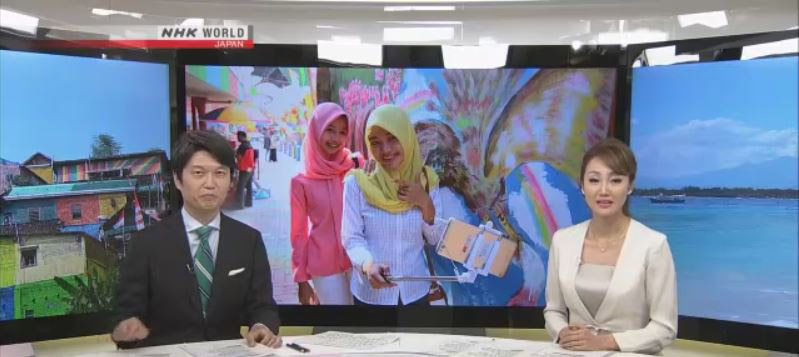
NHK’s Newsroom Tokyo anchors Hideki Nakayama and Aki Shibuya hosting the news feature “Indonesias Efforts Boosting Tourism” which highlights the Indonesia Tourism Ministry’s commitment to, actions and funding of the government’s massive ongoing effort to increase tourism in Indonesia.
Date: September 21, 2017
Source: NHK WORLD
As Indonesias Efforts Boosting Tourism come to fruition, the country is clearly departing from its long dependence on exports of oil and other resources to expand its economy. Now, the government is committed to other sources of growth and the area getting the most attention is tourism.
Indonesia is made up of 17,000 islands — many harboring pristine beaches and lush rainforests. Officials across the country hope to take advantage of these natural assets. They’re also working on other creative projects aimed at luring visitors from overseas.
Lombok Island is considered to have some of Indonesia’s most beautiful beaches. It’s only an hour’s boat ride from Bali, but has far fewer tourists than the famous resorts across the water. “The water is very clear, Nice and sunny. Absolutely beautiful,” says a tourist.
Foreign visitors are spoiled for choice in Indonesia – from temples to markets, rainforests to coral reefs. But the vast majority travel no further than Bali, Jakarta, or Batam Island near Singapore. The government wants to change that. It’s designated 10 regions to be developed as new tourist destinations. Top priority is a district on Lombok Island called Mandalika.
Apart from a beautiful beach, there is hardly any tourist entertainment in Mandalika. But now, the government is massively investing in the area to make it into an enormous resort area like the one in Bali. The Mandalika development project has been designated a special economic zone. The resort will aim to pull in 3 million tourists a year by 2019. Facilities will include a hotel complex, auto race circuit, and water theme park.
Construction workers are already on the job. Officials say the resort will be ready by 2019. Taufan Rahmadi is the government’s man in charge of the project. As appealing as they are, Taufan says white sandy beaches, mountain backdrop and exotic wildlife are not enough. He wants attractions that really stand out.
Taufan says they’re currently building a mosque. The new mosque will be big enough to accommodate 2,000 worshipers. But size is not the main draw. It has a round roof. “The design takes from Bayan mosque, traditional mosque in Lombok,” explains Taufan.
95 percent of the residents on Lombok Island are Muslims. The ethnic Sasaks follow an unorthodox version of Islam – and their buildings have a distinct architecture. The new mosque reflects that local style, creating a religious landmark that Taufan hopes will intrigue Muslims from other countries.
“The Indonesian government believes developing the tourism industry is one of the best ways to promote national growth. I hope to make Mandalika a place that will attract Muslim tourists from around the world,” says Taufan.
The tourism drive is not restricted to the government’s priority regions. An area in Semarang city, about an hour’s plane ride from Jakarta, is attracting attention for its colorful buildings and houses. The vivid colors cry out for social media attention. And it seems to have worked. People now come here to take pictures.
“The village is quite unique and colorful. I wanted to come see it.” “It’s very pretty and clean now, but it used to be a slum before it was painted,” say the tourists. That’s not an exaggeration. Before its technicolor makeover, the village was a shade of grey.
Village officials wanted to change the environment. Making use of a 25,000-dollar donation from local businesses, officials and residents rolled up their sleeves and got to work. By the time the paint ran out, some 240 houses, roads and bridges were ready for the cameras.
“I never imagined our village would become a tourist destination. But once we finished painting, people started coming from outside the village. Nowadays, we’re getting visitors from abroad,” says Erwin Sumarah, Deputy Head of the Wonsari tourism village board.
The mega paint job has boosted incomes, created jobs and made the village safer. Most importantly, the benefits are trickling down to those who need them most.
A woman who operates a shop in the village used to sell soap and cigarettes, but barely made enough to get by. Now, she makes smoothies for tourists — and the profits are sweet. “They say they’re going to make the painted area twice as large as it is now. If more people come to the village, I can make more money,” she says.
Indonesia has given its neighbors a big head-start in tourism, and the industry still has a lot of ground to cover. Public and private sectors are responding with creative ideas – and that’s another resource Indonesia seems to have in abundant supply.